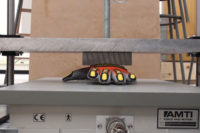
We want to assist you in understanding how cut test methods are performed and calculated into a Cut Level Rating. Currently the cut resistance of protective gloves is assessed using two test methods:
- For the European market, the mandatory standard is EN 388 (first version: 1994 – current version: 2004).
- In the U.S. market, the standard is ASTM F1790 (first version: 1997 – current version: 2005). This method was adopted by ISO in 1999 as an international standard: ISO 13997.
EN method
EN method uses a circular blade with a constant pressure of 5 N (~ 500 grams) applied to the blade. The blade makes an alternating horizontal movement over 50 mm (2 inches) of the glove material and rotates in the opposite direction of the movement. This results in a sinusoidal blade speed with a maximum of 100 mm/second.The value measured is the number of cycles it takes to cut the material. A cotton reference material is used to control the sharpness of the blade. Test on the cotton material is performed before and after test on glove material, then the average value of cycles for the cotton material (Cn) is calculated. This value is correlated with the value obtained for glove material (Tn) using the following equation: In = (Cn + Tn)/Cn, where “In” is the index value for the test sequence. Index value is a number without unit and is also called “cut index”. Five test sequences (cut on the reference/cut on glove material/cut on the reference) are performed and the average index value I is calculated.
EN 388 defines five levels of cut resistance with level 1 being the least and level 5 being the most cut-resistant gloves:
A drawback of the EN test method is that it is not, for the most part, representative of the cut risks end-users are exposed to in industrial workplaces:
- the 5 N (~ 500 grams) pressure applied on the blade is too low;
- the alternating displacement of the blade makes the contact time with the glove sample very short.
ASTM method
ASTM method uses a 50 mm (2 inch) length straight blade, which is moved one time across the glove material under a given load, at a constant speed of 2.5 mm/s. The test result is expressed as the load required to cut the glove material after the blade travels 20 mm (3/4 inch). This load is calledrating force(unit of grams force), with a larger load indicating a higher cut resistance. A series of tests are performed with different loads (minimum three) and blade displacements necessary to cut the sample are recorded. From this data, load vs. distance curve is plotted and the rating force is determined.ASTM method is more representative of workplace conditions vs. the EN method:
- The straight blade cuts the material in a single stroke; which is the mechanism involved when there is a risk of laceration with a sharp edge such as knife or box cutter;
- Various weight loads are applied to the blade as it travels across the glove material.
It is worth noting both cut test methods use control weight, not sudden force, which is very often the case in the workplace. The current ASTM test method will provide a reliable glove selection component when choosing cut protective gloves to protect workers in your facilities.
Moderate/standard protection: Level 1 to 2 according to ANSI/ISEA cut standard. These woven gloves allow the skin to breathe more easily. They are recommended for continuous use in situations where the objects handled are only mildly abrasive, i.e. using a safety knife or handling untrimmed sheet metal.
Heavy duty/high-performance protection: Level 3 to 5 according to ANSI/ISEA cut standard. These gloves have been coated or are multi-layered to improve their resistance to frequent contact with sharp or abrasive objects. As a result, they have a longer service life, i.e. repeated handling of heavy and rough, sharp-edged parts.


